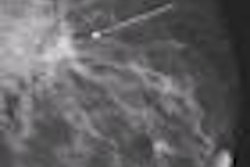Radiation therapy (RT) may provide relief to patients with unpleasant chest symptoms from advanced non-small cell lung cancer if they can tolerate the treatment. But those who could benefit the most may not be strong enough to complete a course of palliative radiation therapy.
Radiation therapy treatments that are scheduled with a two-week break can be a viable option for frail patients, according to a study published in the February issue of the Journal of Thoracic Oncology (2010, Vol. 5:2, pp. 185-190).
The mass effect of tumors in the thorax can cause symptoms such as chest pains, shortness of breath, cough, airway obstruction, cardiac arrhythmia, and esophageal obstruction. Radiation oncologists at the James P. Wilmot Cancer Center at the University of Rochester in Rochester, NY, have been prescribing a split-course hypofractionated radiation therapy schedule for these patients.
The rationale is that the first course of 25 Gy given in 2.5-Gy daily fractions serves as a trial course for assessing treatment tolerance. A 14-day break from palliative radiation therapy enables patients to recover from radiotherapy-induced acute fatigue and potential esophagitis. It also enables physicians to determine if patients are strong enough to complete a second course to a final radiation dose of 50 to 62.5 Gy. Patients with localized diseases were given higher overall doses, with the hope that they would have a more sustained palliative response and might have better local control.
Lead author Dr. Su Metcalfe and colleagues retrospectively reviewed the medical records of 140 patients who received this treatment between 1995 and 2006 to evaluate its effectiveness for symptom relief and to analyze its impact on survival. Fifty-three percent of the patients, who ranged in age from 35 to 92 years, had stage IV disease.
In all, 123 patients (88%) completed the first half of the treatment. All but seven of this group began the second half, and 101 completed the treatment. Of the 39 patients who did not complete the treatment, 11 died, 19 stopped the treatment of their own accord, and the remainder stopped at the recommendation of their physicians.
Symptoms were minimized in 86% of the patients, and 58% experienced durable palliation. Thirty-four percent of the patients experienced grade 1 and 2 esophagitis, and 8% experienced grade 1 and 2 pneumonitis. Only 2% had grade 3 esophagitis during or following the treatment. The patients who developed mild esophagitis were able to recover from it during the 14-day treatment break. None of the patients had any grade 4 or 5 toxicities, according to Metcalfe.
Patients who completed treatment survived a median of 6.5 months. Patients who did not complete either the first or second course of treatment had a median survival of 1.2 months.
By Cynthia E. Keen
AuntMinnie.com staff writer
March 1, 2010
Related Reading
Palliative radiation may cure lung cancer in a very small minority of cases, January 23, 2006
Copyright © 2010 AuntMinnie.com



















